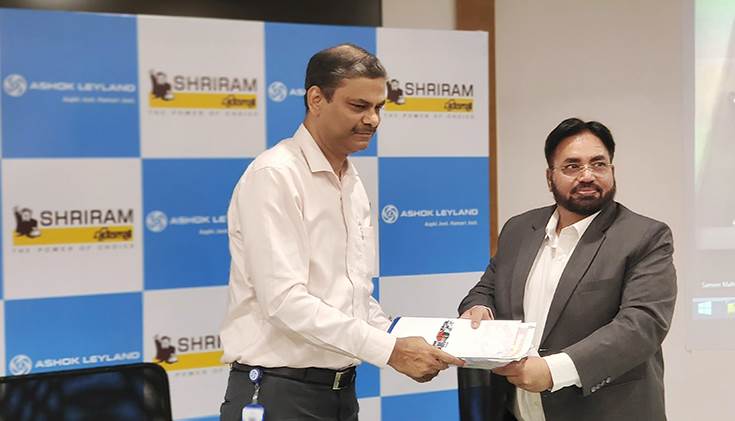In India, economists identify inflation as the greatest risk, as per the survey. New Delhi: While “Covid shock” maintains its number one position among risk factors in leading Asian economies, in India “inflation risk” has replaced it for the first time since the March 2020 poll, according to a latest survey. The Japan Centre for… Continue reading Inflation replaces Covid shock as top risk factor for India
Tag: Mobility
Ashok Leyland enters used CV market with Shriram Auto Mall
Ashok Leyland has entered the used commercial vehicle market in association with Shriram Automall India Ltd (SAMIL). The hybrid ecosystem in the form of a phygital platform will facilitate an exchange and proper disposal and purchase of old commercial vehicles. With the entry into this segment, Ashok Leyland aims to streamline the used vehicle market… Continue reading Ashok Leyland enters used CV market with Shriram Auto Mall
Technavio’s Automotive Gear Shift Systems Market Research Report Highlights the Key Findings in the Area of Vendor Landscape, Key Market Segments, Regions, and Latest Trends and Drivers
Vendor Landscape The worldwide automotive gear shift systems market is dominated by a few well-known manufacturers that are constantly working on developing new gear shift system designs. The prominent vendors are expected to focus on developing solutions for autonomous parking during the forecast period. Automotive gear shift systems are available from prominenet vendors like DURA… Continue reading Technavio’s Automotive Gear Shift Systems Market Research Report Highlights the Key Findings in the Area of Vendor Landscape, Key Market Segments, Regions, and Latest Trends and Drivers
Watch investors speak on opportunities & challenges in deep-tech sector
Investor interest in the nascent deep-tech space — or companies creating a tough-to-replicate, complex, and scientific solution for a problem — is slowly picking up in South and SE Asia. While the deep-tech sector enjoys favourable government policies, particularly in Singapore, the challenge remains in the addressable market size in the region. “If you look… Continue reading Watch investors speak on opportunities & challenges in deep-tech sector
DealStreetAsia’s most read stories of 2021 and what they tell us
The year started out with all of us circumspect, as the pandemic dragged on. But, as we tracked the deals and fundraising in the space, it became clear that both businesses and their investors, looking beyond the near-term challenges, have their eyes on the supercharged growth that Southeast Asia, India and Greater China promise. Our… Continue reading DealStreetAsia’s most read stories of 2021 and what they tell us
Inside Tesla: How Elon Musk Pushed His Vision for Autopilot
To hear more audio stories from publications like The New York Times, download Audm for iPhone or Android. Elon Musk built his electric car company, Tesla, around the promise that it represented the future of driving — a phrase emblazoned on the automaker’s website. Much of that promise was centered on Autopilot, a system of… Continue reading Inside Tesla: How Elon Musk Pushed His Vision for Autopilot
Micromobility in 2022: Refined, mature and packed full of tech
2021 was the year micromobility as a concept, a solution and a way of life really started to settle in. Increased shared micromobility and COVID-ridden public transit helped make small electric vehicles mainstream enough for people to wrap their heads around purchasing their own. Consequently, 2021 was the year of the e-bike, with a growth… Continue reading Micromobility in 2022: Refined, mature and packed full of tech
2022 Predictions for the Insurtech and Gig Economy
by Mark Warnquist, CEO & Co-Founder, and Brandy Mayfield, Chief Underwriting Officer at InShare As 2021 comes to a close, experts in the insurtech and gig economy space, Mark Warnquist, CEO & Co-Founder, and Brandy Mayfield, Chief Underwriting Officer at InShare, offer insights for 2022. Warnquist and Mayfield are both armed with deep knowledge of… Continue reading 2022 Predictions for the Insurtech and Gig Economy
VINFAST DELIVERS FIRST BATCH OF ELECTRIC VEHICLES TO CUSTOMERS IN VIETNAM
The VF e34 is an electric SUV in the C/mid-size segment offering a modern design, impressive acceleration, intuitive operation, and abundant integrated smart features that are researched and developed exclusively for the Vietnamese market. VF e34 has numerous unique features, including its virtual assistant developed by VinBigData, a member company of Vingroup’s technology ecosystem. With multi-regional Vietnamese accent recognition, users… Continue reading VINFAST DELIVERS FIRST BATCH OF ELECTRIC VEHICLES TO CUSTOMERS IN VIETNAM
EV Roundup: NKLA’s SEC Settlement, GM’s ‘Everybody In’ Strategy & More
Nikola NKLA breathed a sigh of relief last week as the electric vehicle (EV) maker managed to pull itself out of the legal challenges that had been troubling it since 2020. The company has agreed to pay the SEC $125-million penalty to bring the controversial chapter to a close. Meanwhile, e-mobility startup Fisker FSR and… Continue reading EV Roundup: NKLA’s SEC Settlement, GM’s ‘Everybody In’ Strategy & More

